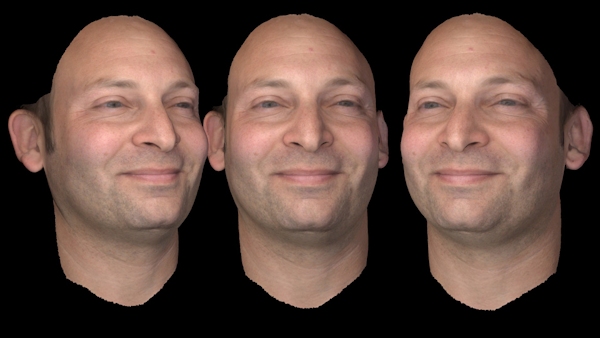[From a large and interesting feature in IEEE Spectrum, “Special Report: The Future We Deserve: The Next 50 Years,” where the story features more images and three videos]
[Image: Digital Ira]
Digital Actors Go Beyond the Uncanny Valley
Computer-generated humans in movies and video games are paving the way for new forms of entertainment
By Tekla S. Perry
Posted 27 May 2014
Say hello to Ira. His head is visible on a screen as though he’s in a videoconference. He seems to be in his early 30s, with a shaved head, a pronounced nose, and thin eyebrows. Ira seems a little goofy and maybe just a wee bit strange. But unless you knew his full name—it’s “Digital Ira”—you probably wouldn’t guess that he’s nothing but bits.
In the background, a graphics processor churns through the calculations that determine every roll of his eyes, every crease or bulge of his skin, and every little arch of his eyebrow. Digital Ira can assume almost any expression—joy, befuddlement, annoyance, surprise, concern, boredom, or pleasure—in about the same amount of time it takes a human to do so.
As Digital Ira affirms, graphics specialists are closing in on one of their field’s longest-standing and most sought-after prizes: an interactive and photo-realistically lifelike digital human. Such a digital double will change the way we think about actors, acting, entertainment, and computer games. In movies, digital doubles already replace human actors on occasion, sometimes just for moments, sometimes for most of a feature film. Within a decade or so, computer-game characters will be as indistinguishable from filmed humans as their movie counterparts. And in time, this capability will help bring movies and games together, and out of the union will come entirely new forms of entertainment.
This blurring of the real and the digital became possible in movies recently when moviemakers reached a long-anticipated milestone: They crossed the “uncanny valley.” The term has been used for years to describe a problem faced by those using computer graphics to depict realistic human characters. When these creations stopped looking cartoonish and started approaching photo-realism, the characters somehow began to seem creepy rather than endearing. Some people speculated that the problem could never be solved; now it has proved to be just a matter of research and computing power.
Producing a fully realistic digital double is still fantastically expensive and time-consuming. It’s cheaper to hire even George Clooney than it is to use computers to generate his state-of-the-art digital double. However, the expense of creating a digital double is dependent on the costs of compute power and memory, and these costs will inevitably fall. Then, by all accounts, digital entertainment will enter a period of fast and turbulent change. An actor’s performance will be separable from his appearance; that is, an actor will be able to play any character—short, tall, old, or young. Some observers also foresee a new category of entertainment, somewhere between movies and games, in which a work has many plotted story lines and the viewer has some freedom to move around within the world of the story.
Creators of entertainment also dream that technology will someday make itself invisible. Instead of painstakingly using cameras and computers to share their visions, they hope to be able to directly share the rich worlds of their imaginations using a form of electronic mind reading far more sophisticated than the brain-scan technology of today: If you can think it, you will be able to make someone see it.
“That is the future I wish for—where the hard edges of technology disappear and we return to magic,” says Alexander McDowell, a professor at the University of Southern California’s School of Cinematic Arts.
That magic means not only being able to step inside a realistic virtual world without the cumbersome—and, for some, nauseating—head-mounted screens that create virtual experiences today. It means being able to seamlessly merge the real and the virtual, to allow computer-generated beings to walk among real humans.
[Read the rest at IEEE Spectrum]
